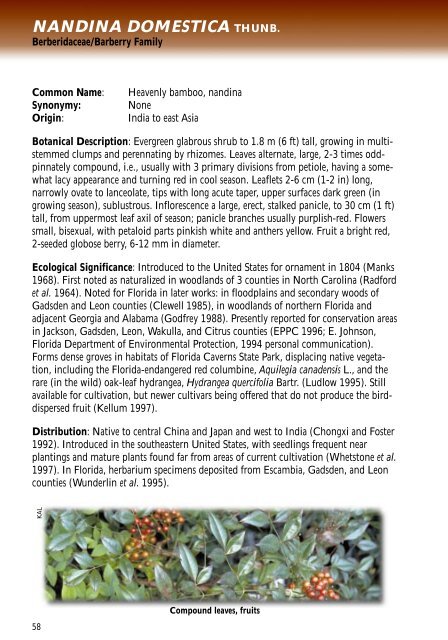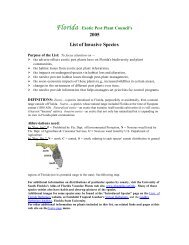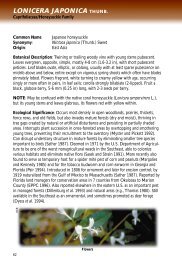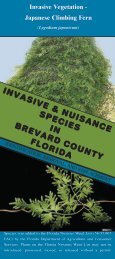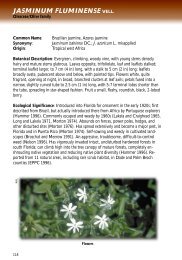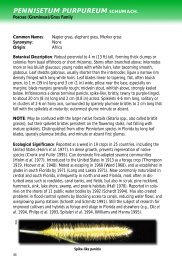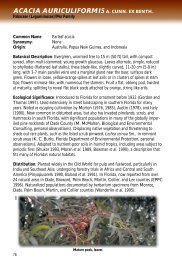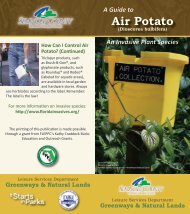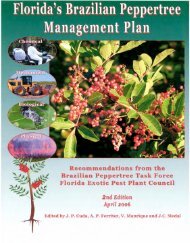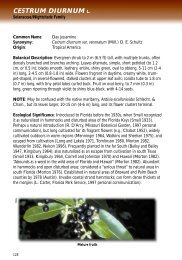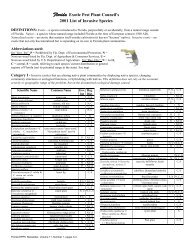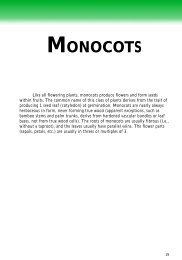DICOTS - Florida Exotic Pest Plant Council
DICOTS - Florida Exotic Pest Plant Council
DICOTS - Florida Exotic Pest Plant Council
You also want an ePaper? Increase the reach of your titles
YUMPU automatically turns print PDFs into web optimized ePapers that Google loves.
Nandina domestica Thunb.<br />
Berberidaceae/Barberry Family<br />
Common Name: Heavenly bamboo, nandina<br />
Synonymy: None<br />
Origin: India to east Asia<br />
Botanical Description: Evergreen glabrous shrub to 1.8 m (6 ft) tall, growing in multistemmed<br />
clumps and perennating by rhizomes. Leaves alternate, large, 2-3 times oddpinnately<br />
compound, i.e., usually with 3 primary divisions from petiole, having a somewhat<br />
lacy appearance and turning red in cool season. Leaflets 2-6 cm (1-2 in) long,<br />
narrowly ovate to lanceolate, tips with long acute taper, upper surfaces dark green (in<br />
growing season), sublustrous. Inflorescence a large, erect, stalked panicle, to 30 cm (1 ft)<br />
tall, from uppermost leaf axil of season; panicle branches usually purplish-red. Flowers<br />
small, bisexual, with petaloid parts pinkish white and anthers yellow. Fruit a bright red,<br />
2-seeded globose berry, 6-12 mm in diameter.<br />
Ecological Significance: Introduced to the United States for ornament in 1804 (Manks<br />
1968). First noted as naturalized in woodlands of 3 counties in North Carolina (Radford<br />
et al. 1964). Noted for <strong>Florida</strong> in later works: in floodplains and secondary woods of<br />
Gadsden and Leon counties (Clewell 1985), in woodlands of northern <strong>Florida</strong> and<br />
adjacent Georgia and Alabama (Godfrey 1988). Presently reported for conservation areas<br />
in Jackson, Gadsden, Leon, Wakulla, and Citrus counties (EPPC 1996; E. Johnson,<br />
<strong>Florida</strong> Department of Environmental Protection, 1994 personal communication).<br />
Forms dense groves in habitats of <strong>Florida</strong> Caverns State Park, displacing native vegetation,<br />
including the <strong>Florida</strong>-endangered red columbine, Aquilegia canadensis L., and the<br />
rare (in the wild) oak-leaf hydrangea, Hydrangea quercifolia Bartr. (Ludlow 1995). Still<br />
available for cultivation, but newer cultivars being offered that do not produce the birddispersed<br />
fruit (Kellum 1997).<br />
Distribution: Native to central China and Japan and west to India (Chongxi and Foster<br />
1992). Introduced in the southeastern United States, with seedlings frequent near<br />
plantings and mature plants found far from areas of current cultivation (Whetstone et al.<br />
1997). In <strong>Florida</strong>, herbarium specimens deposited from Escambia, Gadsden, and Leon<br />
counties (Wunderlin et al. 1995).<br />
KAL<br />
58<br />
Compound leaves, fruits


